Hung Le
Pick
SPaRFT: Self-Paced Reinforcement Fine-Tuning for Large Language Models
Aug 07, 2025Abstract:Large language models (LLMs) have shown strong reasoning capabilities when fine-tuned with reinforcement learning (RL). However, such methods require extensive data and compute, making them impractical for smaller models. Current approaches to curriculum learning or data selection are largely heuristic-driven or demand extensive computational resources, limiting their scalability and generalizability. We propose \textbf{SPaRFT}, a self-paced learning framework that enables efficient learning based on the capability of the model being trained through optimizing which data to use and when. First, we apply \emph{cluster-based data reduction} to partition training data by semantics and difficulty, extracting a compact yet diverse subset that reduces redundancy. Then, a \emph{multi-armed bandit} treats data clusters as arms, optimized to allocate training samples based on model current performance. Experiments across multiple reasoning benchmarks show that SPaRFT achieves comparable or better accuracy than state-of-the-art baselines while using up to \(100\times\) fewer samples. Ablation studies and analyses further highlight the importance of both data clustering and adaptive selection. Our results demonstrate that carefully curated, performance-driven training curricula can unlock strong reasoning abilities in LLMs with minimal resources.
DmC: Nearest Neighbor Guidance Diffusion Model for Offline Cross-domain Reinforcement Learning
Jul 28, 2025Abstract:Cross-domain offline reinforcement learning (RL) seeks to enhance sample efficiency in offline RL by utilizing additional offline source datasets. A key challenge is to identify and utilize source samples that are most relevant to the target domain. Existing approaches address this challenge by measuring domain gaps through domain classifiers, target transition dynamics modeling, or mutual information estimation using contrastive loss. However, these methods often require large target datasets, which is impractical in many real-world scenarios. In this work, we address cross-domain offline RL under a limited target data setting, identifying two primary challenges: (1) Dataset imbalance, which is caused by large source and small target datasets and leads to overfitting in neural network-based domain gap estimators, resulting in uninformative measurements; and (2) Partial domain overlap, where only a subset of the source data is closely aligned with the target domain. To overcome these issues, we propose DmC, a novel framework for cross-domain offline RL with limited target samples. Specifically, DmC utilizes $k$-nearest neighbor ($k$-NN) based estimation to measure domain proximity without neural network training, effectively mitigating overfitting. Then, by utilizing this domain proximity, we introduce a nearest-neighbor-guided diffusion model to generate additional source samples that are better aligned with the target domain, thus enhancing policy learning with more effective source samples. Through theoretical analysis and extensive experiments in diverse MuJoCo environments, we demonstrate that DmC significantly outperforms state-of-the-art cross-domain offline RL methods, achieving substantial performance gains.
Hybrid Cross-domain Robust Reinforcement Learning
May 29, 2025Abstract:Robust reinforcement learning (RL) aims to learn policies that remain effective despite uncertainties in its environment, which frequently arise in real-world applications due to variations in environment dynamics. The robust RL methods learn a robust policy by maximizing value under the worst-case models within a predefined uncertainty set. Offline robust RL algorithms are particularly promising in scenarios where only a fixed dataset is available and new data cannot be collected. However, these approaches often require extensive offline data, and gathering such datasets for specific tasks in specific environments can be both costly and time-consuming. Using an imperfect simulator offers a faster, cheaper, and safer way to collect data for training, but it can suffer from dynamics mismatch. In this paper, we introduce HYDRO, the first Hybrid Cross-Domain Robust RL framework designed to address these challenges. HYDRO utilizes an online simulator to complement the limited amount of offline datasets in the non-trivial context of robust RL. By measuring and minimizing performance gaps between the simulator and the worst-case models in the uncertainty set, HYDRO employs novel uncertainty filtering and prioritized sampling to select the most relevant and reliable simulator samples. Our extensive experiments demonstrate HYDRO's superior performance over existing methods across various tasks, underscoring its potential to improve sample efficiency in offline robust RL.
Beyond the Known: Decision Making with Counterfactual Reasoning Decision Transformer
May 14, 2025Abstract:Decision Transformers (DT) play a crucial role in modern reinforcement learning, leveraging offline datasets to achieve impressive results across various domains. However, DT requires high-quality, comprehensive data to perform optimally. In real-world applications, the lack of training data and the scarcity of optimal behaviours make training on offline datasets challenging, as suboptimal data can hinder performance. To address this, we propose the Counterfactual Reasoning Decision Transformer (CRDT), a novel framework inspired by counterfactual reasoning. CRDT enhances DT ability to reason beyond known data by generating and utilizing counterfactual experiences, enabling improved decision-making in unseen scenarios. Experiments across Atari and D4RL benchmarks, including scenarios with limited data and altered dynamics, demonstrate that CRDT outperforms conventional DT approaches. Additionally, reasoning counterfactually allows the DT agent to obtain stitching abilities, combining suboptimal trajectories, without architectural modifications. These results highlight the potential of counterfactual reasoning to enhance reinforcement learning agents' performance and generalization capabilities.
Reasoning Under 1 Billion: Memory-Augmented Reinforcement Learning for Large Language Models
Apr 03, 2025Abstract:Recent advances in fine-tuning large language models (LLMs) with reinforcement learning (RL) have shown promising improvements in complex reasoning tasks, particularly when paired with chain-of-thought (CoT) prompting. However, these successes have been largely demonstrated on large-scale models with billions of parameters, where a strong pretraining foundation ensures effective initial exploration. In contrast, RL remains challenging for tiny LLMs with 1 billion parameters or fewer because they lack the necessary pretraining strength to explore effectively, often leading to suboptimal reasoning patterns. This work introduces a novel intrinsic motivation approach that leverages episodic memory to address this challenge, improving tiny LLMs in CoT reasoning tasks. Inspired by human memory-driven learning, our method leverages successful reasoning patterns stored in memory while allowing for controlled exploration to generate novel responses. Intrinsic rewards are computed efficiently using a kNN-based episodic memory, allowing the model to discover new reasoning strategies while quickly adapting to effective past solutions. Experiments on fine-tuning GSM8K and AI-MO datasets demonstrate that our approach significantly enhances smaller LLMs' sample efficiency and generalization capability, making RL-based reasoning improvements more accessible in low-resource settings.
Sparse Mixture of Experts as Unified Competitive Learning
Mar 29, 2025Abstract:Sparse Mixture of Experts (SMoE) improves the efficiency of large language model training by directing input tokens to a subset of experts. Despite its success in generation tasks, its generalization ability remains an open question. In this paper, we demonstrate that current SMoEs, which fall into two categories: (1) Token Choice ;and (2) Expert Choice, struggle with tasks such as the Massive Text Embedding Benchmark (MTEB). By analyzing their mechanism through the lens of competitive learning, our study finds that the Token Choice approach may overly focus on irrelevant experts, while the Expert Choice approach risks discarding important tokens, potentially affecting performance. Motivated by this analysis, we propose Unified Competitive Learning SMoE (USMoE), a novel and efficient framework designed to improve the performance of existing SMoEs in both scenarios: with and without training. Extensive experiments across various tasks show that USMoE achieves up to a 10% improvement over traditional approaches or reduces computational inference costs by 14% while maintaining strong performance.
S2MoE: Robust Sparse Mixture of Experts via Stochastic Learning
Mar 29, 2025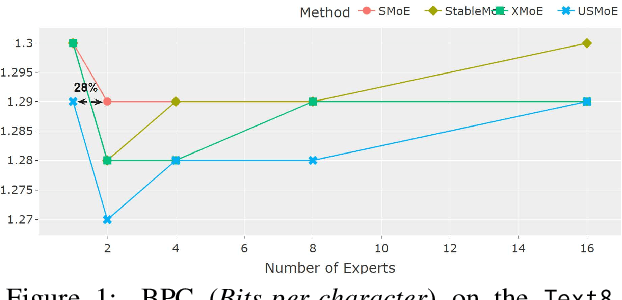
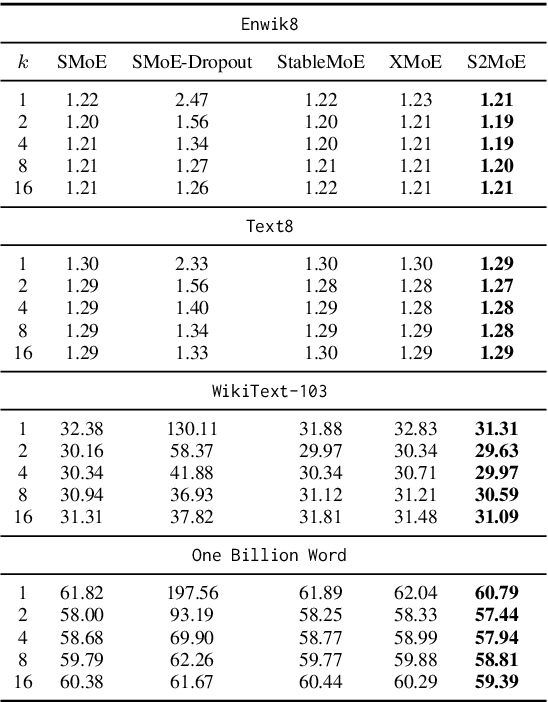
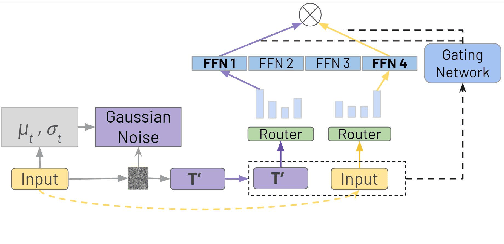
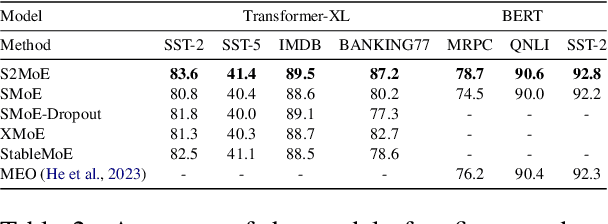
Abstract:Sparse Mixture of Experts (SMoE) enables efficient training of large language models by routing input tokens to a select number of experts. However, training SMoE remains challenging due to the issue of representation collapse. Recent studies have focused on improving the router to mitigate this problem, but existing approaches face two key limitations: (1) expert embeddings are significantly smaller than the model's dimension, contributing to representation collapse, and (2) routing each input to the Top-K experts can cause them to learn overly similar features. In this work, we propose a novel approach called Robust Sparse Mixture of Experts via Stochastic Learning (S2MoE), which is a mixture of experts designed to learn from both deterministic and non-deterministic inputs via Learning under Uncertainty. Extensive experiments across various tasks demonstrate that S2MoE achieves performance comparable to other routing methods while reducing computational inference costs by 28%.
On the effectiveness of discrete representations in sparse mixture of experts
Nov 28, 2024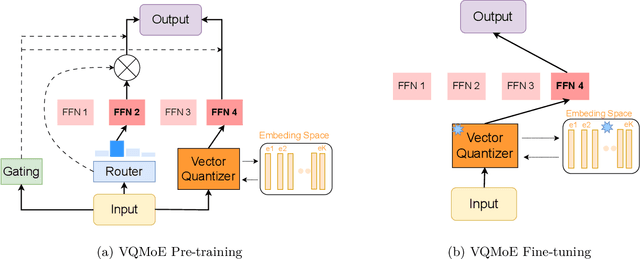



Abstract:Sparse mixture of experts (SMoE) is an effective solution for scaling up model capacity without increasing the computational costs. A crucial component of SMoE is the router, responsible for directing the input to relevant experts; however, it also presents a major weakness, leading to routing inconsistencies and representation collapse issues. Instead of fixing the router like previous works, we propose an alternative that assigns experts to input via indirection, which employs the discrete representation of input that points to the expert. The discrete representations are learnt via vector quantization, resulting in a new architecture dubbed Vector-Quantized Mixture of Experts (VQMoE). We provide theoretical support and empirical evidence demonstrating the VQMoE's ability to overcome the challenges present in traditional routers. Through extensive evaluations on both large language models and vision tasks for pre-training and fine-tuning, we show that VQMoE achieves a 28% improvement in robustness compared to other SMoE routing methods, while maintaining strong performance in fine-tuning tasks.
CodeTree: Agent-guided Tree Search for Code Generation with Large Language Models
Nov 07, 2024



Abstract:Pre-trained on massive amounts of code and text data, large language models (LLMs) have demonstrated remarkable achievements in performing code generation tasks. With additional execution-based feedback, these models can act as agents with capabilities to self-refine and improve generated code autonomously. However, on challenging coding tasks with extremely large search space, current agentic approaches still struggle with multi-stage planning, generating, and debugging. To address this problem, we propose CodeTree, a framework for LLM agents to efficiently explore the search space in different stages of the code generation process. Specifically, we adopted a unified tree structure to explicitly explore different coding strategies, generate corresponding coding solutions, and subsequently refine the solutions. In each stage, critical decision-making (ranking, termination, expanding) of the exploration process is guided by both the environmental execution-based feedback and LLM-agent-generated feedback. We comprehensively evaluated CodeTree on 7 code generation benchmarks and demonstrated the significant performance gains of CodeTree against strong baselines. Using GPT-4o as the base model, we consistently achieved top results of 95.1 on HumanEval, 98.7 on MBPP, and 43.0 on CodeContests. On the challenging SWEBench benchmark, our approach led to significant performance gains.
Stable Hadamard Memory: Revitalizing Memory-Augmented Agents for Reinforcement Learning
Oct 14, 2024
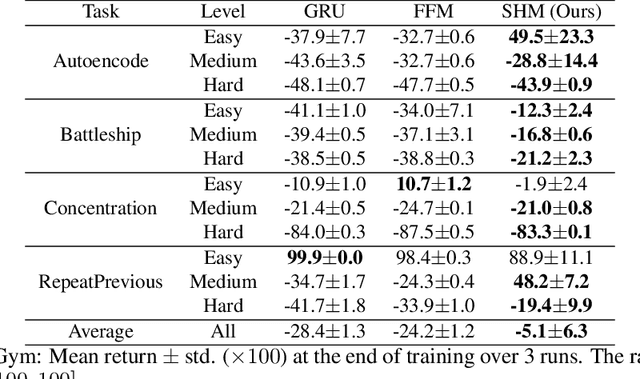


Abstract:Effective decision-making in partially observable environments demands robust memory management. Despite their success in supervised learning, current deep-learning memory models struggle in reinforcement learning environments that are partially observable and long-term. They fail to efficiently capture relevant past information, adapt flexibly to changing observations, and maintain stable updates over long episodes. We theoretically analyze the limitations of existing memory models within a unified framework and introduce the Stable Hadamard Memory, a novel memory model for reinforcement learning agents. Our model dynamically adjusts memory by erasing no longer needed experiences and reinforcing crucial ones computationally efficiently. To this end, we leverage the Hadamard product for calibrating and updating memory, specifically designed to enhance memory capacity while mitigating numerical and learning challenges. Our approach significantly outperforms state-of-the-art memory-based methods on challenging partially observable benchmarks, such as meta-reinforcement learning, long-horizon credit assignment, and POPGym, demonstrating superior performance in handling long-term and evolving contexts.
 Add to Chrome
Add to Chrome Add to Firefox
Add to Firefox Add to Edge
Add to Edge